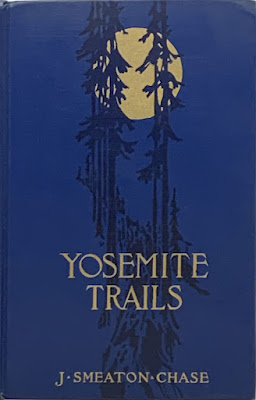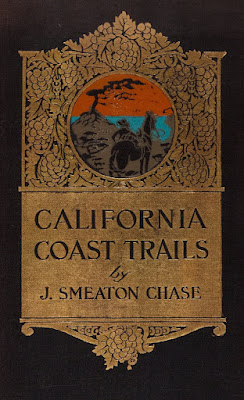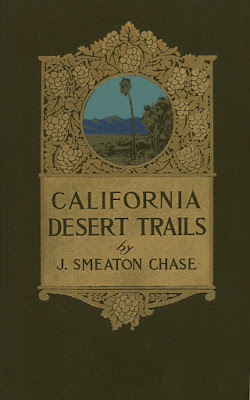A Trilogy of Trails Books by J. Smeaton Chase
While not hiking anywhere particularly new or interesting in the recent months, I have still managed to have a little project on. I have pulled together, mostly from Internet Archive material, a set of e-books that chronicle some of the travels of one J. Smeaton Chase. These are in epub format. As it is essentially a zip archive of html files, it should be pretty universal. Not nearly so universal as a text file, but with infinitely more formatting and picture including capability, so I think it's worth the compatibility hit.
Chase was born in 1864 and seems to have spent some time in rainy Cumbria (it gets a few mentions) before emigrating to California in 1890. He only saw the east as he transferred onto a train and watched it pass into the distance. He deposited his money in a bank which promptly lost it. (This gets no mention, but is found here.) From there, there are many odd jobs, social work, and travel that make up his life.
There are only provided for personal reading. Click on the covers to download the books. The descriptions might contain spoilers, particularly after the first paragraph. I'm not sure what constitutes a spoiler or if it is really a thing for a travel book.

The first of these books is Yosemite Trails; Camp and Pack-train in the Yosemite Region of the Sierra Nevada, published in 1911. This is nominally a guide book. A few chapters do support this purpose, especially those primarily concerned with conifers. One chapter details everything except the sequoias, including a breakdown of the elevations to find them, and could still be seen as important today. A second chapter is entirely devoted to sequoias, but has little adventure stories that fill it out. Little adventure stories creep into other chapters as well.
The great majority of the book details two major travels. The first (which actually appears second) is a long guide supported trek through the high country and down to Mono Lake. They travel more northerly than the maps they brought or the guide's experience, so spend a great period uncertain where they are. Perhaps not lost, as they are still sure of being able to get back, but they do find great difficulty in finding the routes they want. This doesn't quite seem like a guide book to me.
The second trip (which appears first) is his own little project: circumnavigating the Yosemite rim. This is supported by a rented horse and mule and a much shorter trip.
Taken all together, it all gives a picture of Yosemite that is both familiar and strange. It is interesting to see Tioga Road, a main travel route today, described as "historic" in a book over 100 years old. "Deserted cabins" mark places you've probably heard of. And all of it is told with a grand bit of enthusiasm, especially when it comes to his passion, the conifer.
There's a touch of camp etiquette thrown in as he tells of having to put out someone's campfire that has been left to steadily grow into a nearby log. (For some reason, these stories still need to be told.) He doesn't seem all that enamored with the then typical habit of leaving empty cans at campsites, either. But the greatest thing in this and all of these is to see a familiar place in a different light.

The second book is California Coast Trails; a Horseback Ride from Mexico to Oregon, published in 1913. This is a travel book and structured similarly to Three Men in a Boat by Jerome K. Jerome, and I'm sure there's many more. (Then again, Wikipedia states that Jerome's book was intended as a serious travel guide in 1889, so perhaps so is this. There is a helpful equipment list.) This time, his little project was to ride along the coast from Mexico to Oregon. He actually left his home in El Monte to ride south in 1910 for the first part of the journey. The following year, he left again from El Monte going north. It sounds like Santa Monica was already a bit of a circus and he pointedly missed it. Again, there are familiar places that haven't changed and others that are much changed. I expect those around Los Angeles would get a special thrill out of the crossing of the Malibu Ranch. I also thrill with the travel around Point Conception, which is now Hollister Ranch. Both of these mentioned a bit of trespass.
This is also a California in the midst of change as the automobile is taking hold. The other two books do not show this so much, but traveling the coast areas necessarily passes through some of the spaces where the automobile was first adopted. We see county roads that are no more than a single track, not even sufficient for a wagon to travel, and we see roads full of automobiles that seem intent on spooking the horse as they honk going past.
We get a little extra reflection about San Francisco since it is not his first visit. He was also there just after the earthquake and fire, so compares the two times, just a few years apart. Then it's onto a ferry and to the more sparsely populated northern half of the state.
He shows himself to be a bit of a Social Justice Warrior, making a point to comment on the many delightful people from diverse cultures that he encounters along the way. He is rather overt that the various prejudices people harbor are unfounded. (He's not perfect. He did not like one town in particular along the way, and I noted only one of the two nationalities mentioned as the primary inhabitants get a positive mention later on.)
Even when things get rough, he has a tendency to spin it with wit. I got a particular kick out of his time at Fernbridge, even if it was under an unfamiliar name, since I have passed a sign for "Historic Bridge Fernbridge" many times.
At Singley I met the northern division of the Northwestern Pacific Railway, the southern part of which I had left two hundred miles to the south. Here also I crossed the Eel River, paying toll for the use of a bridge which, as I found when I came to the place where it should have been, did not exist. It was an interesting question whether I had paid my “two bits” for the view of the ruins of the old bridge, or as a forced contribution toward the cost of the fine new one which I saw at a little distance upstream, nearly ready for use.
It is at this point that I remember that the year on that sign is 1911. I guess that was late 1911, as he was passing through in October. I have not yet had to pay a toll for the crossing on the rather narrow old bridge. Singley Bar is just down the river where some stub ends of road can still be found, pointing at each other but unjoined.

The third book, California Desert Trails, was not published until 1919. This is more like the first in ostensibly being a guide book. There are chapters on geography and plants and lore prior to getting down to telling a travel story. The initial chapters have a few additional stories to whet the appetite for the main event. In this one, he took on the little project of circumnavigating the Colorado Desert, the area between the Mojave Desert and the Sonoran Desert.
Quite without explanation, he took this on at the height of summer. He does mention he was delayed in his start by 2 months, but as the trip took 3 months, that would have still placed some of the travel during summer's peak. The appendix at the end reproducing some of a USGS document with suggestions about desert travel suggests this isn't a good idea unless you know the area very well. (He didn't, but he did gather as much information as he could.) He managed to ignore other points of advice, too, but did get a horse that was used to desert conditions. Kaweah was an absolute superhero.
Again, he meets many people along the way that delight him. Oh, and he's not above saying land was stolen, both in the abstract and in the specific. On the other hand, he's religious enough to try never to travel on a Sunday (although chores like mending are fine fillers for this time) and he has a huge blind spot for the activities of those building missions. Missions and conifers seem to be his greatest passions. He even makes an overt, though sarcastic, comment about white supremacy. Being sarcastic, it would be easy to read the other way, but taken with the nearby comment that he suspects he'd rather have been hosted by the Mexican family who were in the home before as well as quite a few other comments, it seems he's against. He then proceeds to offer his superior fashion sense a couple chapters later, but nobody is perfect. He's got a difficult relationship with women, too. In the specific, they are certainly people, but in the abstract, they are harder to pin down.
Of course, it is the desert that takes center stage. Its plants, its waters, its heats. Mazes with a hundred stories, and a general hope but not certainty of not becoming the next. Long travel into the night because needs must be met before one stops. Ponderances of gold and a general determination not to come under its siren call. He seems not to like it, which is odd considering this is the one book for which he was still in the place as he wrote it. He does try to address it once, but I found this a more melancholy book than the others. Then again, within these pages is a call for a national park, which the mighty redwoods did not get. Another difficult relationship.
Liked this? Interesting? Click the three bars at the top left for the menu to read more or subscribe!




Comments
Although I am not positive, I believe these are strike anywhere matches that are in a block form, either collected at the base somehow, or cut with the base still intact, so that you may pull off a match for use. [Possibly like those pairs of disposable chopsticks that one pulls apart.]
You may see two other variants at Civil War Talk https://civilwartalk.com/threads/block-matches.24322/
My belief in part stems from descriptions of matches contained in an excerpt from Glossary for the Worldwide Transportation of Dangerous Goods and Hazardous Materials and from CargoHandbook.com . There is also an article and picture in Wikipedia, wherein it states: "Early matches were made from blocks of woods with cuts separating the splints but leaving their bases attached. Later versions were made in the form of thin combs. The splints would be broken away from the comb when required."
Hope this helps answer a bit of curiosity. It amuses me that starting a fire with a spark from a ferrocerium rod required a discovery made in 1903 by an Austrian, Carl Auer, yet matches were around much longer.
something new and inspiring when reading Chase. Much more there is about Chase....
material. Have you ever considered illustrating some of the passages of his books? Might
you considered a project together matching his writing with paintings? I've subscribed to
your blog but not sure why my ID isn't coming up. You can comment on my blog here:
https://josephsmeatonchase.blogspot.com Thanks! Jim
If anyone needs a clickable link to that, here it is: Joseph Smeaton Chase blog